About the Artifact

© Canadian Museum of Civilization, VI-I- 66, Photo Marie-Louise Deruaz, IMG2010-0112-0012-Dm
“Skin toboggan. Made of moose skin, from the lower part of the limbs. The hair is oriented in one direction, to facilitate sliding on the snow. In front, two leather attachments [made from 2-strand twisted rawhide (furred)]. To these, the braided line is attached for pulling the toboggan. Made by the Tizya family in the 1930s. Used traditionally by the early trappers on the trapping trail, when a small load with supplies and necessities was estimated sufficient. Only human traction was used with this skin toboggan”.
— Richard Slobodin, 1963–1964
“Caribou-leg-skin sleds were traditionally used by Gwich’in to pack belongings during winter travel. Not as big as toboggans, they were often pulled by people, rather than dogs. These sleds were approximately 2 m in length, though Dorothy Alexie had seen one 4 m in length that was pulled by dogs. Like the caribou-leg-skin bags, caribou-leg-skin sleds were constructed with the hair-side out, which was extremely slippery on the ice and snow. The main body was made of caribou-leg skins, and sometimes moose-leg skins, sewn together. The rim of the sled was made of tanned moose skin (dinjik dhoh dì’ nadhi’ee). The lacing at the rim of the sled (vitł’yaa) and the bag strap (khah deetł’yàa) were made of raw cleaned caribou skin (aajii). The rope on the sled wrapper was made of braided babiche (tł’yah nìltł’yaa). People packed belongings, such as their pots and pans, in these sleds, and sometimes people rode in them. Kids enjoyed taking them sliding when empty, though parents discouraged this because it expedites the hair wearing off …”
— Fort McPherson Gwich’in Elders, 2007